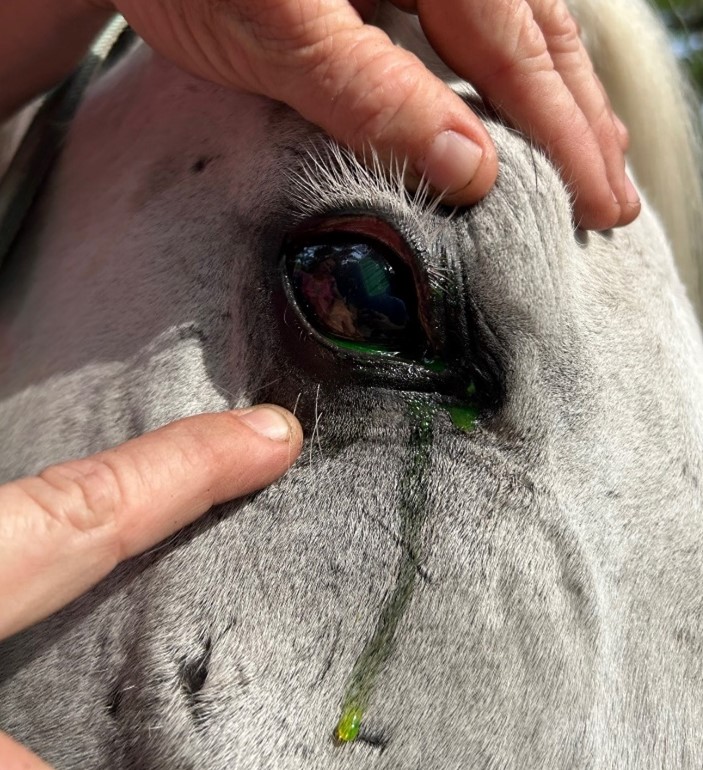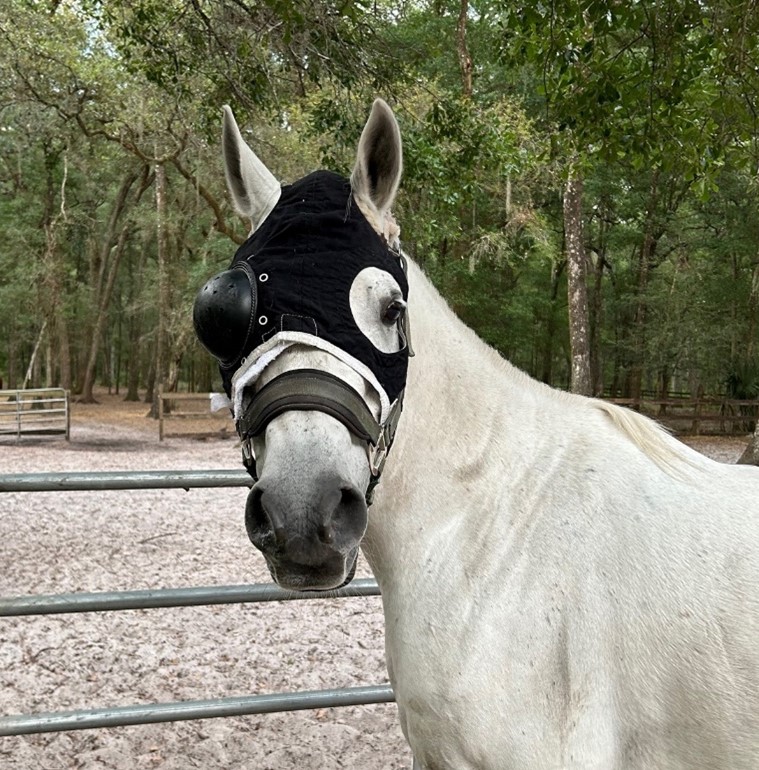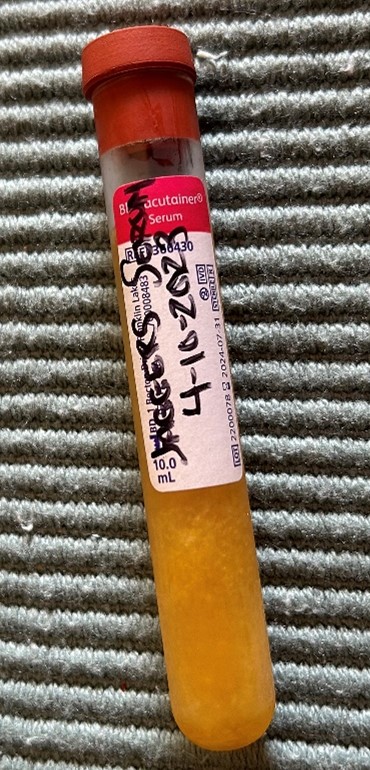The cornea of the eye is the outside cellular layer of the eyeball, which functions as a protective barrier, and helps focus light on the retina located at the back of the horse’s eye. A corneal ulcer is defined as a lesion in which the outer layer (epithelium) and some of the middle layer (stroma) of the cornea have been damaged (usually the result of a scratch on the surface of the eye). Corneal ulcers are a common equine ophthalmic condition that can quickly progress to a more serious problem without prompt diagnosis and treatment.
Routinely monitoring the horse’s eyes during feeding and grooming is extremely important, as this allows owners to catch and address eye problems immediately. Corneal ulcers and other eye injuries should be considered emergencies and owners should contact their horse’s veterinarian if any of the following signs are observed:
- Squinting
- Tearing
- Intolerance to bright sunlight
- Eye appears cloudy
- Eye appears red, and/or swollen
Mechanical causes of corneal ulcers include abrasions/scratches, foreign objects that attach to the cornea (e.g., a grass seed head), or ingrown eyelashes. Particularly this time of year, exposure to insects (flies, gnats, and mosquitos) and allergens such as pollen can lead to eye irritation. Horses may also become itchy due to allergic skin conditions and are thus more likely to rub their head and face on objects in the pasture or stall, which can result in injury to the eye(s). Corneal ulcers can also be caused by infectious organisms such as bacteria, fungi, or viruses. Unfortunately, environmental conditions in Florida make horses more susceptible to fungal infections associated with corneal ulceration. This often leads to the need for more aggressive treatment, and the ulcer taking longer to heal, or in some cases may require removal of the eye.

Veterinarian performing an ophthalmological exam with fluorescent staining of the eye. This procedure makes the abrasion on the cornea easier to see and evaluate. Credit: Carissa Wickens, UF/IFAS
Diagnosis consists of a complete ophthalmological exam performed by a veterinarian. Proper lighting and equipment and staining of the eye with fluorescent dye allows the veterinarian to detect and evaluate the ulcer, which is crucial in determining if further diagnostics are needed, and to implement the best options for treatment. While waiting for the veterinarian to arrive, bring the horse into a stall and place a fly mask on their face (if you do not have access to a stall, place the horse in a more shaded area of the farm with a fly mask).
Treatment of corneal ulcers in horses is aimed at controlling pain and wound healing. Additional supportive management can help prevent further injury to the eye. The veterinarian may prescribe a non-steroidal anti-inflammatory drug, e.g., flunixin meglumine (Banamine) or phenylbutazone (bute) to reduce pain and inflammation. Atropine ointment may also be prescribed to manage eye pain. Atropine relaxes the eye muscles, dilating the pupil, so horses treated with atropine should be kept out of direct light. A fly mask or a blinker can be worn to help prevent exposure to direct sunlight and to protect the eye during treatment and recovery. A triple antibiotic ointment (Neomycin, Polymyxin B Sulfates, Bacitracin Zinc; NPB) is typically administered for wound healing, and the veterinarian may also prescribe silver sulfadiazine (SSD) ointment to reduce the risk of fungal infection. These ointments usually need to be administered three or more times per day.

This horse is wearing a blinker to help prevent further injury to the eye during treatment. This horse’s treatment regimen included application of atropine ointment which dilates the pupil, thus without access to a stall, the blinker also serves to protect the eye from direct light. Credit: Carissa Wickens, UF/IFAS
–

Vial of autologous serum. Application of the horse’s own serum as part of the treatment protocol can aid in corneal ulcer healing. Carrot stretches and positive reinforcement-based training were helpful in administering this horse’s eye medications. Credit: Carissa Wickens, UF/IFAS
More recent medical treatment for corneal ulcers includes administering the horse’s own blood serum (autologous serum) to the eye. Some studies have provided evidence that this promotes corneal healing. Uncomplicated ulcers often heal within 3 to 7 days, but treatment can extend 1-2 weeks. The horse may be aversive and grow intolerant to repeated application of eye medications and this can make it difficult on the owner and the horse to administer treatment safely and effectively. Positive reinforcement can be used to train and reward the horse to accept repeated application of eye medications, but some horses will require a sub-palpebral lavage (a soft, flexible catheter inserted in the upper eyelid and extended back along the horse’s neck which allows the handler to deliver medication to the eye without being near the horse’s head). Application of sub-palpebral lavage requires the horse to be kept in a stall during treatment.
Most horses at some point in their life will get a corneal ulcer, but there are measures owners can take to help prevent or minimize the risk of eye ulcers. Avoid hooks or sharp points in the stall. Keep fences in good repair and remove broken tree branches and debris from pastures to help prevent scratches/abrasions. Fly masks can also be worn to help protect the horse’s eyes from irritants such as insects, dirt, seed heads etc. Remember to observe the horse’s eyes on a regular basis for early signs of eye problems.
–
References and further reading:
Brooks, D. 2016. Equine ophthalmology for horse owners. American Association of Equine Practitioners. Accessed on May 2, 2023.
Pearson, Gemma. 2018. Don’t Break Your Vet – Happy Heads. YouTube Video. Accessed on May 4, 2023.
